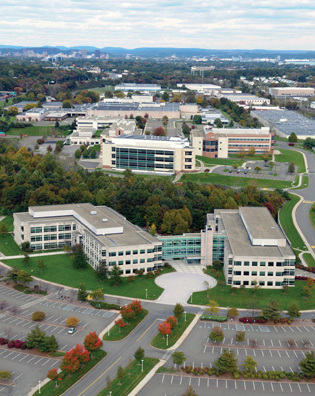 loading
loading
featuresDeal of the centuryWhen Yale got a chance at a billion dollars' worth of land and scientific infrastructure for ten cents on the dollar, they bought first and asked questions later. Now, the West Campus is starting to take shape.  Michael MarslandYale's new West Campus is in West Haven and Orange, Connecticut, seven miles southwest of the central campus in New Haven (visible at top left). View full image
The first thing you notice when you visit Yale’s new West Campus—after you talk your way past a friendly but serious security checkpoint at the main entrance—is how big the place feels. It’s nearly a mile from one end of the property to the other, or about the distance from Phelps Gate to the Divinity School. The second thing you notice is how quiet it is. Well, quiet isn’t exactly the right word; there is a steady stream of white noise from the adjacent Interstate 95. It’s more like emptiness. Even at their busiest, suburban corporate campuses are far less lively than urban college campuses, but here the vast parking lots are empty, the sidewalks are empty, the fully furnished office cubicles visible through the windows are empty, and the chairs and tables outside the cafeteria are empty. It’s as if a couple thousand people up and disappeared—which is pretty much what happened. Just a few years ago, two thousand employees of Bayer Pharmaceutical were working on the 136-acre site in West Haven and Orange, manufacturing drugs and conducting research in a complex that had grown over several decades to include 20 buildings. When Bayer announced in 2006 that it would leave Connecticut and sell the campus, Yale stepped in and bought it at a bargain-basement price. (See "Yale Buys a Second Campus," July/August 2007.) The only question remaining was what to do with the new acquisition, which Yale dubbed the West Campus. "The usual paradigm in academia is an abundance of creative ideas and little infrastructure to implement them," says Stephanie Spangler, a deputy provost who is also an associate vice president for West Campus planning. "In this case, we had the infrastructure and had the opportunity to generate the ideas.” Three years after the purchase became final, plans for the West Campus have begun to take shape. The research labs—the main attractions of the property—are beginning to be used for a constellation of interdisciplinary science initiatives that are attracting new research faculty to Yale. The university’s museums and libraries are taking portions of the vast factory and warehouse spaces for conservation projects and enhanced, accessible storage for their collections. A conference center with a 250-seat auditorium is being well used by groups from the central campus for retreats and seminars. About 120 people are now working at the West Campus. Michael Donoghue, the Yale vice president overseeing development of the site, says that by 2020, there will be well over a thousand. The empty cubicles would be filled much faster if Yale had decided to use its new property to relieve crowding on the main campus. But from the beginning, the strategy has been to use the West Campus to expand Yale’s reach in the sciences and try out new initiatives in the arts. "The notion that it would just be overflow space was anathema," says Donoghue, a biology professor and former director of the Peabody Museum of Natural History. "We want to have a transformative effect on the university.”
Yale Vice President Bruce Alexander ’65 says he and president Richard Levin ’74PhD were interested in the property from the time Bayer announced it was leaving, but they agreed it would be best for the region if another pharmaceutical company took over and preserved the site’s 2,000 jobs. Alexander kept a watchful eye on the place, however, and by the spring of 2007, "two things were clear: no pharmaceutical company was interested, and it was an amazing property for Yale.” Alexander took Andrew Hamilton, who was then Yale’s provost (and now heads the University of Oxford), out to see the property. Hamilton is a chemist, and when they toured the high-tech labs, says Alexander, "Andy’s eyes grew wide.” Lab space can cost up to $800 per square foot to build, and some of Bayer’s labs were better equipped than even the newest at Yale. Moreover, because much of the salaries and expenses of research faculty in the sciences are covered by federal grants, by far the biggest barrier to Yale’s desire to expand in the sciences has been finding the land and money for new labs. If the university could get Bayer’s laboratories—some half a billion dollars’ worth—at a bargain price, it was an incredible opportunity. Fortunately for Yale, none of the other bidders had any interest in the lab space. Most wanted to tear down some of the buildings and redevelop the property with big-box retail, so they bid as if the site were much less developed than it was. It was as if someone were selling a house with a fully equipped observatory on the roof, and Yale was the only other astronomy buff in town. Yale won the bid with an offer of $109 million, acquiring the land, the buildings, and the equipment, including a large assortment of extremely expensive scientific instruments. "There’s at least a billion dollars in infrastructure out there," says Alexander, who retired from a career as a developer before coming to Yale. "I’ve been in real estate my whole life, and this was the best real estate deal I ever made.”
|
|